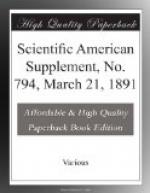Having had control of the apparatus for several months, and, with the aid of a reliable assistant, having checked everything that went in and came out of the generator, I am in a position to state authoritatively that, using ordinary gas coke and a petroleum of specific gravity ranging from 0.689 to 0.709, 1,000 cubic feet of gas, having an illuminating power of twenty-two candles, can be made with an expenditure of 28 to 32 lb. of coke and 21/2 gallons of petroleum. The most important factors, i.e., the quantity of petroleum and the illuminating value of the gas, have also been checked and corroborated by Mr. Heisch and Mr. Leicester Greville.
Total gas made = 8,700 cubic feet.
Time taken: Blowing. 1 hour. Time taken: Making. 50 minutes.
Fuel used: Gas coke.
270 lb. = 31 lb. per 1,000 c.f.
Fuel used: Naphtha, sp. gr. 0.709.
34 gals. = 2.7 gals. per 1,000 c.f.
Illuminating power of gas = 21.9 candles.
I must admit that these results far exceeded my expectations, although they only confirmed the figures claimed by the patentee; and there are not wanting indications that, when worked on a large scale and continuously, they might be even still further lowered, as it is impossible to obtain the most economical results when making less than 10,000 cubic feet of the gas, as the proper temperature of the walls of the generator are not obtained until after several makes; and it is only after about 8,000 cubic feet of gas has been made that the best conditions are fulfilled.
It will enable a sounder judgment to be formed of the working of the process if the complete experimental figures for a make of gas be taken.
COMPOSITION OF THE GAS.
Hydrogen. 46.75
Olefines. 7.59
Ethane. 6.82
Methane. 11.27
Carbon monoxide. 11.65
Carbon dioxide. 0.50
Oxygen. 0.17
Nitrogen. 8.25
-------
100.00
UNPURIFIED GAS CONTAINED
Carbon dioxide. 2.32 per cent.
Sulphureted hydrogen. 2.84 "
Total sulphur per 100 cu. ft. = 6.67
Ammonia. nil
Bisulphide of carbon. nil
Gas produced Naphtha
used
Gals. Pts.
1st. Make. 3,600 cu. ft. 10 7
2d. " 2,800 " 7 6
3d. " 2,300 " 5 3
------ --- --
8,700 24 0
The last portion of the table shows the economy which arises as the whole apparatus gets properly heated. Thus the first make used 3 gallons naphtha per 1,000 cubic feet, the second 2 gallons 6 pints per 1,000 cubic feet, and the third 2 gallons 4 pints per 1,000 cubic feet, and it is, therefore, not unreasonable to suppose that in a continuous make these figures could be kept up, if not actually reduced still lower.




